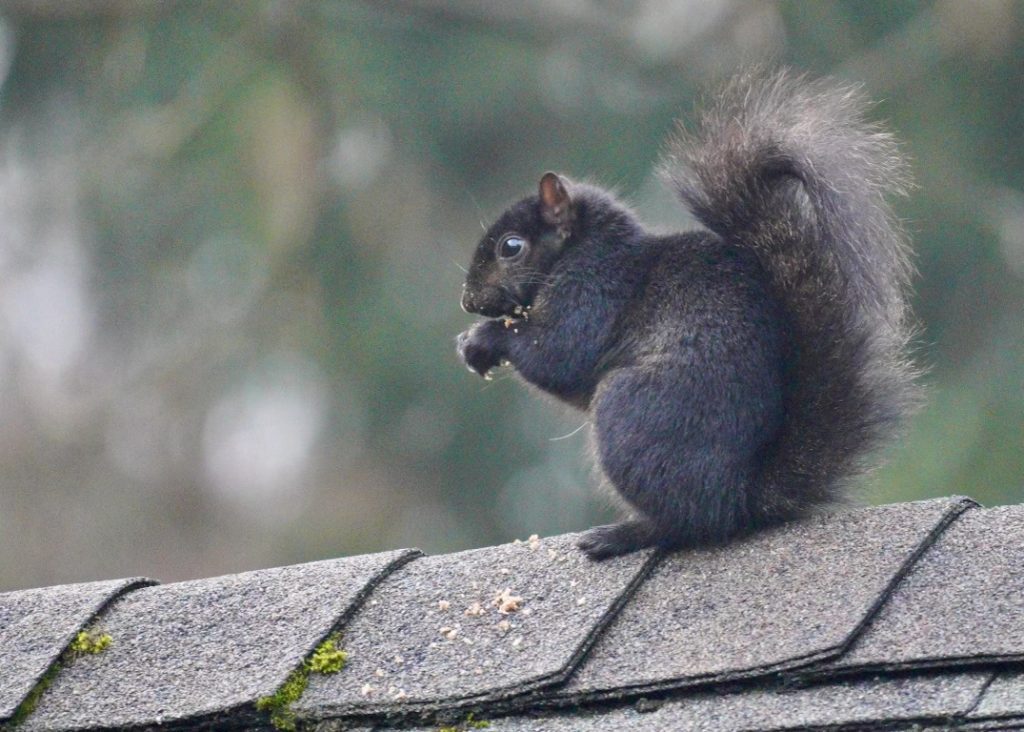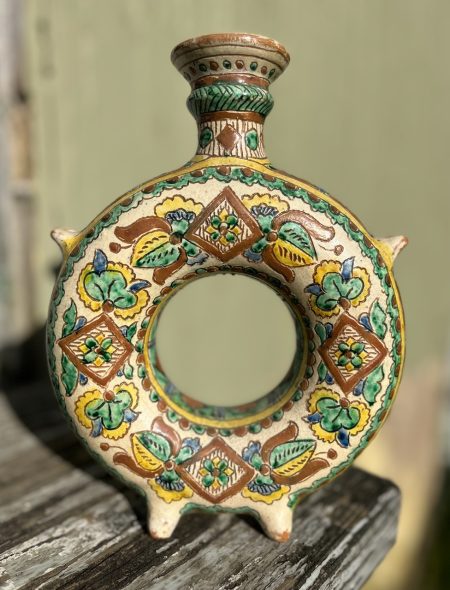I initially thought a black cat had crossed my path, but when I looked again out the window, I realized it was not a cat – it was a black squirrel, and quite a large one at that.
Black squirrels are usually a melanistic version of eastern gray squirrels and relatively rare. Across the country, the number of normal gray squirrels is about 10,000 times more than black squirrels, but in some areas, black squirrels are fairly common, such as in the Larchmont neighborhood in Westchester County, NY, and parts of Ohio, Maryland, Michigan, Houston Texas, Indiana, Iowa, Wisconsin, and Minnesota.
One such place where black squirrels are common is the Larchmont neighborhood in Westchester County, NY, where my daughter Alex and her family live. During a recent visit there, I saw the black squirrel searching for food in her backyard, which my daughter said is a regular sight there. Other areas in the country where groups of black squirrels are common include parts of Ohio, Maryland, Michigan, Houston Texas, Indiana, Iowa, Wisconsin, and Minnesota.
The farther north you go, the more likely you are to see a black squirrel. In Pennsylvania, the most likely region to encounter one is in the north central counties like McKean, Potter, and Tioga. I haven't seen any black squirrels here in Chester County, but we have plenty of gray squirrels at our bird feeder.
Like in other mammals, black squirrels are the result of melanism, which leads to black or very dark-colored individuals. On the other hand, albinism is a rare genetic condition caused by mutations that limit the amount of melanin the body produces. Animals with albinism also have eyes without pigment, sometimes appearing pink or red.
Despite spending a lot of time in the deer woods, I've never seen an albino deer. However, I have come across piebald deer, including a doe last season. Piebaldism results from a portion of the skin lacking melanocytes, the cells that produce pigment, caused by recessive genetic traits. In deer, this results in uneven, blotchy coats with patches of white and brown.
Another condition resulting from a partial lack of melanin is leucism. Leucism doesn't affect eye color, unlike albinism. It's rarely seen in wild birds, but I once encountered an almost all-white catbird with leucism two years ago. Studies have shown that only about 1 bird in 30,000 has leucistic or albinistic plumage. Meanwhile, piebald deer are much more common, with around 1 in 1,000 deer showing the trait. Albinism is even rarer, occurring in only 1 in 30,000 deer. Overall, when it comes to melanism versus albinism in wildlife, melanism tends to be somewhat rarer.
While the black squirrel I saw in my daughter’s backyard seemed quite large, black squirrels are not inherently bigger than their gray counterparts, which can grow to 20 inches in length and weigh about one and a half pounds. There are five types of squirrels in Penn’s Woods: red squirrels, gray squirrels, fox squirrels, northern flying squirrels, and southern flying squirrels. The largest of these is the fox squirrel, which can grow to 30 inches in length and weigh three pounds. Currently, fox squirrels in Pennsylvania range far west of our southeast corner. Similar to the eastern gray squirrel, fox squirrels also exhibit melanism at about the same rate as gray squirrels.
The smallest squirrel is the southern flying squirrel, which weighs 1.8 to 2.5 ounces and is 8 to 10 inches long. The slightly larger northern flying squirrel can weigh 2 to 4.4 ounces and grow from 9.8 to 11.5 inches long. In Pennsylvania, the increasingly rare northern flying squirrel is limited to the northernmost pine woods, while the southern flying squirrel is more common. Both species are active at night and are rarely seen during the day, but they may visit bird feeders after dark. The rate of melanism in these squirrels is similar to that of gray squirrels.
Although the gray squirrel is the most common in our state, the red squirrel is a close second in the southeastern corner. Red squirrels, at eight inches long and eight and a half ounces, are half the size of gray squirrels but more aggressive. They are usually not affected by melanism, so black red squirrels are extremely rare.
If you keep a close lookout, you might eventually see a black gray squirrel, especially in the state's northern counties.
VOLUNTEERS NEEDED FOR RED CLAY CLEANUP SATURDAY
Eight hundred volunteers are required for the annual Red Clay Valley Clean Up on Saturday, March 23rd from 8 AM to Noon. The Clean Up is co-sponsored by the Brandywine Red Clay Alliance (BRC), Delaware Nature Society (DNS), Mt. Cuba Center and Kennett Area Park Authority (KAPA) to collect litter along more than 100 miles of stream and roadways along the east and west branches of the Red Clay Creek.
Volunteers are essential for the success of the Red Clay Valley Clean Up. In over 30 years, volunteers have collected 431 tons of trash from streams and roadways. Jim Jordan, the chair of the Red Clay Clean Up event, notes that this is an annual spring tradition for many in the community. Necessary materials (gloves, bags, reflective safety vests, etc.) are provided. Volunteers can register at www.brandywineredclay.org. For questions, call (610-793-1090) or email [email protected].
The Brandywine Red Clay Alliance aims to promote the restoration, conservation, and enjoyment of the natural resources of the Brandywine and Red Clay Watersheds through education, scientific activities, environmental stewardship, and advocacy.
This community effort would not be possible without the generous support of: Brandywine Red Clay Alliance, Bike Delaware, Chandler Funeral Homes, Delaware Nature Society, Wild Birds Unlimited-Hockessin, Kennett Area Park Authority, Mt. Cuba Center, Phillips Mushroom Farms, Veolia Delaware, WSFS, Flyway Excavating, Manfredi Cold Storage, Marty’s Contracting, Champion Trophies & Promotional Products.
Thanks for volunteering!
Tom Tatum writes about the outdoors for the MediaNews Group. You can contact him at [email protected].









